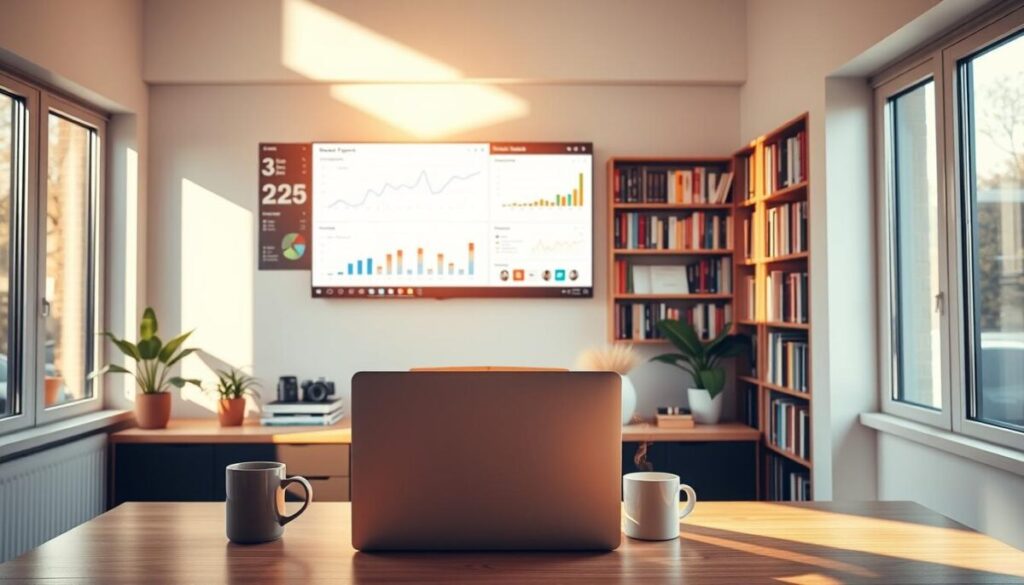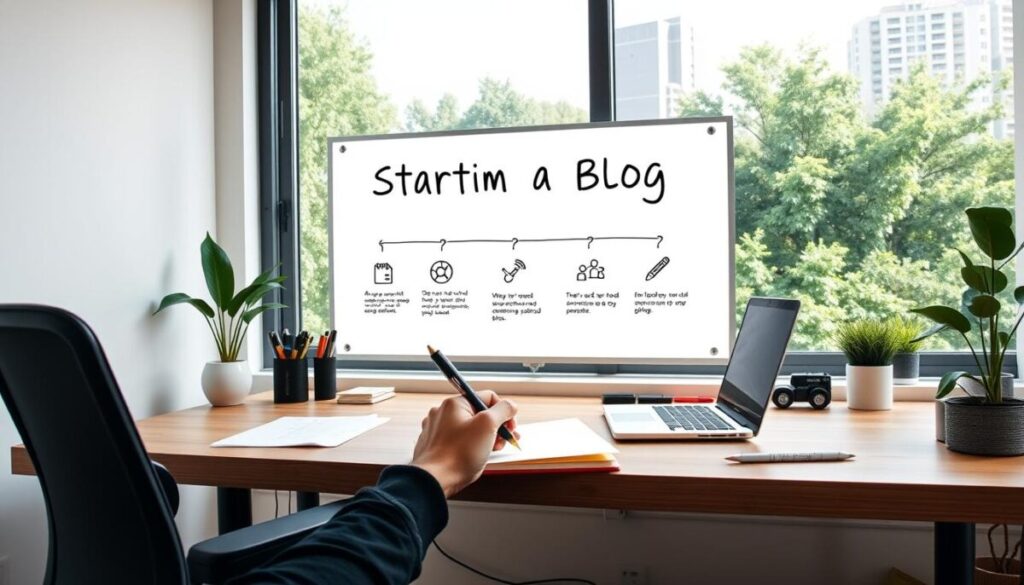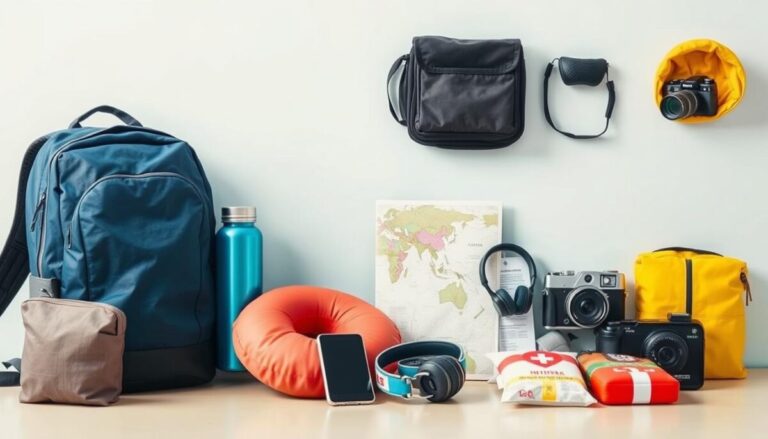
Ready to share your voice online and build an audience? Starting a blog might seem hard, but it’s easy with the right help. Scott Chow says you can start a blog in 20 minutes with basic computer skills.
You don’t need to be tech-savvy to start blogging. Simple strategies and beginner-friendly tips can help you start with confidence. This guide will cover the basics of blogging and help you build a strong online presence.
Key Takeaways
- Learn how to start a blog quickly and easily
- Discover beginner-friendly blogging tips
- Understand the basics of creating a successful blog
- Get started with confidence using our easy blogging guide
- Establish a strong online presence with your new blog
Why Blogging Matters in 2025

In 2025, blogging is as important as ever. It offers many benefits for both individuals and professionals. It’s a key way to express yourself, learn new things, and grow in your career.
The Evolution of Blogging
Blogging has changed a lot over the years. It started as a personal online diary but has grown into a powerful tool. Now, it’s used to shape opinions, market products, and share knowledge.
Technology and how people use the internet have driven these changes. Today’s blogging platforms are advanced, with lots of customization options and social media integration.
Benefits of Starting Your Own Blog
Starting a blog can be very rewarding. It boosts your credibility, sharpens your writing, and lets you express yourself freely.
Some key benefits include:
- Improved writing and communication skills
- Increased online presence and credibility
- Opportunities for monetization through advertising and sponsored content
- A platform for sharing knowledge and experiences
Blogging offers many benefits in today’s world. It can earn you extra credits in school, help in job interviews, and be a fun hobby. Here’s a table showing some of the main benefits of blogging:
| Benefit | Description | Impact |
|---|---|---|
| Personal Development | Improves writing and communication skills | Enhances confidence and credibility |
| Professional Opportunities | Opens up opportunities for freelance writing and collaborations | Increases career prospects |
| Monetization | Allows for advertising and sponsored content | Provides a potentially profitable source of income |
Starting a Blog: Essential First Steps

Starting a blog needs careful planning and several initial steps. As a beginner, knowing the key elements is vital. These elements will guide your blogging journey.
Finding Your Blogging Niche
Finding your niche is the first big step. Your niche is the specific topic your blog will cover. It’s important to pick something you love and has many followers. Popular niches include lifestyle, technology, health, and finance.
Think about your hobbies, what you’re good at, and what you love. This will help you find your niche.
Scott Chow says a clear niche leads to focused content. This content will connect with your audience better. It can also make your blog more visible and engaging.
Defining Your Target Audience
Knowing your target audience is key to creating content they’ll love. Your target audience is who you want to reach with your blog. Think about their age, gender, location, and interests. Creating buyer personas can help you see your ideal reader.
Experts say knowing your audience makes your content more relevant and fun. This is important for keeping readers coming back.
Setting Clear Blogging Goals
Setting clear goals gives direction to your blogging. Your goals might be to get more visitors, get leads, or make money from your blog. Specific, measurable, achievable, relevant, and time-bound (SMART) goals work best.
“Setting clear goals helps you stay focused and motivated. It also allows you to measure your progress and make necessary adjustments.”
By following these first steps, you’ll start a successful blog. It will attract and keep a loyal audience.
Choosing the Right Blogging Platform

Starting your blogging journey means picking a platform first. This choice affects your blogging experience, flexibility, and online growth.
Self-Hosted vs. Free Platforms
You have two main choices: self-hosted or free platforms. Self-hosted blogs give you control and flexibility. You own your content and can customize your site. Free platforms are easy to set up but limit customization and monetization.
Self-hosted platforms, like WordPress, need a domain and hosting. This gives you full control. It’s best for long-term blogging or a professional online presence.
WordPress, Blogger, Medium: Pros and Cons
Here’s a comparison of popular platforms:
| Platform | Pros | Cons |
|---|---|---|
| WordPress | Highly customizable, SEO-friendly, extensive plugin library | Requires technical knowledge, costs associated with hosting and premium themes/plugins |
| Blogger | Free to use, integrates well with Google services, easy to set up | Limited customization options, less control over design and functionality |
| Medium | Simple and clean interface, built-in audience, easy to use | Limited control over design and monetization, less SEO-friendly |
WordPress is popular for its flexibility and customization. It’s great for bloggers but needs technical skills. Blogger and Medium are simpler but have their own limits.
Technical Requirements for Beginners
For beginners, knowing your platform’s technical needs is key. Self-hosted WordPress blogs need a reliable host. Bluehost is a good choice for its reliability and support.
Also, consider how easy it is to install and set up your blog. Many hosts offer 1-click WordPress installations. Learn your platform’s dashboard and resources to start.
By weighing your options and understanding technical needs, you can pick a platform that fits your goals.
Setting Up Your Blog: A Step-by-Step Guide
Starting a blog is exciting. Let’s get into the technical steps. We’ll cover everything from picking a domain name to installing plugins.
Selecting a Domain Name
Your domain name is your blog’s online address. It should be easy to remember and spell. It should also match your blog’s content.
- Keep it short and simple
- Avoid numbers and hyphens if possible
- Use keywords related to your niche
- Check for availability on social media platforms
After picking a name, register it with a trusted registrar like GoDaddy or Namecheap.
Choosing a Hosting Provider
A hosting provider stores your blog’s files. For beginners, Bluehost is a great choice. It’s easy to use and works well with WordPress. When picking a host, think about:
- Reliability and uptime
- Customer support
- Scalability options
- Price and plans
| Hosting Provider | Ease of Use | WordPress Integration | Customer Support |
|---|---|---|---|
| Bluehost | Easy | Seamless | 24/7 Support |
| SiteGround | Moderate | Easy | 24/7 Support |
| HostGator | Easy | Moderate | 24/7 Support |
Installing and Configuring Your Blog
Most hosts offer a 1-click WordPress install. After installing, set up basic settings like:
- Setting your site title and tagline
- Creating a strong admin password
- Configuring permalinks for SEO
Essential Plugins and Tools
Plugins add features to your WordPress blog. Beginners should use:
- Yoast SEO for search engine optimization
- Wordfence for security
- Jetpack for performance and security
These plugins improve your blog’s performance, security, and visibility.
Designing Your Blog for Success
A well-designed blog attracts readers and improves their experience. Your blog’s design is key to its success. It affects how visitors see your content and whether they stay or leave.
Selecting the Right Theme
Choosing the right theme is the first step in making your blog appealing. WordPress themes are popular for their flexibility and customization options. When picking a theme, think about:
- Ease of navigation
- Responsiveness (mobile-friendliness)
- Customization options
- Compatibility with plugins
Choose a theme that is clean, simple, and fits your blog’s niche. A cluttered or outdated theme can scare off visitors. A modern, responsive design can greatly improve user experience.
Creating an Effective Layout
An effective layout guides visitors through your content. Consider these elements when designing your blog’s layout:
- Header with clear navigation
- Prominent call-to-action (CTA)
- Sidebar for additional information or links
- Footer with contact information and social media links
Make sure your layout is intuitive and easy to navigate. A well-structured layout improves user experience and encourages visitors to explore more.
Mobile Optimization Essentials
Most internet users access content on mobile devices. Mobile optimization is essential. A responsive design adjusts to fit different screen sizes, ensuring your blog looks great on all devices.
| Feature | Importance | Impact on User Experience |
|---|---|---|
| Responsive Design | High | Ensures accessibility across devices |
| Fast Loading Speed | High | Reduces bounce rates |
| Easy Navigation | Medium | Improves overall user satisfaction |
By focusing on these key aspects of blog design, you can make a compelling and user-friendly blog. Your blog’s design reflects your brand. So, invest time to get it right.
Creating Compelling Content for New Bloggers
As a new blogger, making engaging content is key to keeping your audience interested. Your blog’s content is its core, drawing readers back for more. To succeed, focus on creating informative, engaging, and relevant content for your audience.
How to Write Your First Blog Post
Starting your first blog post can feel daunting, but it’s a vital step. Pick a topic you love, making the writing fun and your passion clear to readers. Keep it simple and focused, avoiding jargon and complex ideas.
“The best way to get started is to quit talking and begin doing,” Walt Disney said. In your first post, introduce yourself and your blog. Explain what readers can expect and share your goals.
Content Planning and Editorial Calendar
Planning your content is key to keeping your blog fresh and consistent. An editorial calendar helps organize your ideas and schedule posts. Focus on themes or topics that fit your blog’s niche and appeal to your audience.
To make a good editorial calendar, brainstorm topics and sort them by relevance and priority. Use tools like Google Calendar, Trello, or Asana to plan and remind yourself of upcoming posts.
Incorporating Images and Media
Adding high-quality images and media can greatly improve your blog posts. Visuals help break up text, explain complex ideas, and boost social media sharing. Choose images that match your content and add value to your story.
Make sure you have the right to use any images you add. Use free resources like Unsplash, Pexels, or Pixabay for quality images. Also, compress your images to speed up your blog’s load time.
Growing Your Blog’s Audience
To grow your blog’s audience, you need a few key strategies. You must make your blog more visible, engaging, and easy to find for your target audience.
SEO Basics for Beginners
Search Engine Optimization (SEO) is key to getting your blog seen on search engines like Google. Start by conducting keyword research to find terms your audience uses. Use these keywords in your posts, titles, and meta descriptions.
Make sure your blog is mobile-friendly and loads quickly. These factors help your blog rank higher in search results.
Leveraging Social Media
Social media is great for promoting your blog and connecting with your audience. Create profiles on platforms like Facebook, Twitter, Instagram, and Pinterest. Share your content often.
Use engaging visuals and compelling captions to draw in followers. Talk back to your audience by replying to comments and messages. You can also run social media ads to reach more people.
Building an Email List from Day One
Having an email list lets you directly reach your readers and share your content. Offer incentives like free e-books or exclusive content to get people to subscribe. Use tools like Mailchimp or ConvertKit to manage your list.
Send regular updates about new posts, behind-the-scenes content, or special offers. This keeps your audience interested and engaged.
Networking with Other Bloggers
Networking with other bloggers in your niche can expand your audience and boost your credibility. Participate in blogging communities and forums. Work with other bloggers on projects or guest posts.
Go to blogging conferences or webinars to meet other bloggers and experts. Building real relationships with fellow bloggers can open up new opportunities and attract more readers.
Conclusion: Your Blogging Journey Starts Now
You now have the key knowledge to start your blogging journey. Scott Chow says, “The good news is that the internet is exploding with growth right now.” This makes it a great time for new bloggers to start.
Starting a blog might seem tough, but it’s doable when you break it down. You’ve learned how to pick the right platform, set up your blog, make engaging content, and grow your audience.
As you start your blogging journey, remember to stay consistent and patient. Don’t get discouraged by early challenges or slow growth. Keep going and you’ll build a successful blog that connects with your audience.
Now, it’s time to take the first step. Start your blogging journey today. You’ll be on your way to sharing your ideas, meeting like-minded people, and maybe even making money from your blog.
FAQ
What are the benefits of starting a blog?
How do I choose the right niche for my blog?
What is the difference between self-hosted and free blogging platforms?
How do I optimize my blog for mobile devices?
What are some effective ways to promote my blog?
How often should I post new content on my blog?
What are some essential plugins and tools for bloggers?
How do I create a content calendar for my blog?
What are some common mistakes to avoid when starting a blog?
How can I monetize my blog?
Frequently Asked Questions
- Q: What are the benefits of starting a blog?
- A: A blog can make you an expert in your field. It helps you build a community and can even make money. You can earn through ads, sponsored posts, and affiliate marketing.
- Q: What is the difference between self-hosted and free blogging platforms?
- A: Self-hosted sites like WordPress give you more control. Free sites like Blogger or Medium have limits on design and making money.
- Q: How can I monetize my blog?
- A: Make money through ads, sponsored content, and affiliate marketing. You can also sell digital products or offer services like consulting.
Share :
You Might Also Like







